Remember the Alamo—but don’t forget the other four Spanish missions built along the San Antonio River three centuries ago.
Magnificent and mysterious, these missions are the bearers of secrets, from the origins of faded frescoes on stone church walls to the identities of unknown artists and masons.
They are the keepers of the flame of the Coahuiltecans, the Native Americans who gave up their language, religion and nomadic way of life to become farmers and ranchers at the mission compounds they helped build.
And the missions tell the story of how merging cultures laid the foundation for San Antonio, a vibrant and multicultural city.
The Alamo, of course—founded in 1718 as Mission San Antonio de Valero, the first of the five missions established along the river—is a must-see. But when you tire of the crush of the crowds at this Texas shrine, head just south of downtown to the San Antonio Missions National Historical Park, where there’s ample room to quietly roam the grounds of these four missions that still hold regular church services.
Here’s a look at the four missions—each spaced two to three miles apart—that are listed in order heading south from the Alamo. For more information about daily tours, call (210) 932-1001 or go to www.nps.gov/saan.
Mission Nuestra Señora de la Purísima Concepción de Acuña
Founded in 1731 on the east bank of the river, the mission built nearest to the Alamo traces its roots to 1716 in East Texas. The twin bell towers of the church stand as a reminder that the missions “were the first skyline in Texas,” says park ranger Dan Hollifield. Dedicated in 1755, this is considered the oldest, unrestored stone church in the nation.
Mission Concepción’s history reads like a mystery novel, from the remnants of elaborate frescoes on the church’s façade to the steep, winding stone stairs that lead to the office of the Father President, the supervisor of all mission activity.
Mission San José y San Miguel de Aguayo
Set aside extra time to tour the 6-acre Mission San José—the Queen of the Missions—which served as Texas’ largest Spanish mission compound. Founded in 1720 on the west bank of the San Antonio River, it is the city’s second oldest mission. Of particular interest is the restored, water-powered gristmill built around 1794.
This mission zealously guards its secrets: Art historians and architects come from all over the world to study the famous Rose Window on the south wall of the sacristy, but no one knows who created this exquisite example of Spanish Colonial Baroque architecture with its winding and curling tendril-like scrolls. Was the window carved by carpenter Pedro Huizar, whose sweetheart Rosa was lost at sea? Or, in a more likely theory, was it named for Saint Rose of Lima, the first canonized saint of the New World?
Architecture aficionados also come here to study the ornate façade of the limestone church. Considered one of the finest examples of Spanish Colonial Baroque architecture in the United States, the façade depicts Christ’s family tree with statues and other intricate carvings.
Mission San Juan Capistrano
Mission San Juan’s history dates to 1716, when it originally was built as Mission San José de los Nazonis in East Texas. The mission was re-established, and then renamed, on the east bank of the San Antonio River in 1731.
Mission San Juan, the least developed of the San Antonio missions, struggled to make progress in the face of Apache raids and disease outbreaks. The mission never completed construction of a permanent church—another building was converted to a church—but it did make its mark in agriculture, thanks to rich farmland that produced corn, sweet potatoes, squash, sugar cane and wheat. Plans are under way to build a Spanish Colonial demonstration farm here.
Mission San Francisco de la Espada
Mission Espada—or Mission of Saint Francis of the Sword—originally was established as Mission San Francisco de los Tejas near the Neches River in 1690. It moved to the west bank of the San Antonio River in 1731.
Of the four missions, Espada boasts the best-preserved acequia system, with the irrigation ditches still carrying water to nearby farms. Espada Dam, completed by 1745, diverts river water into an acequia madre—mother ditch—and through the Espada Aqueduct, a National Historic Landmark that’s the oldest Spanish aqueduct in the United States.
——————–
Camille Wheeler is staff writer for Texas Co-op Power.



